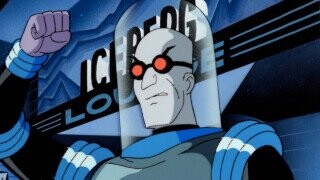Mr. Freeze’s Original Backstory Was Dumb As Hell

While he hasn’t starred in his own billion-dollar Scorsese knock-off (yet), one of Batman’s greatest advisories is that bald blue weirdo who’s forced to live in Haagen-Dazs temperatures at all times: Mr. Freeze. Most of us are probably more familiar with the pathos-infused iteration of the character that originated in Batman: The Animated Series; the iconic cartoon was the first to portray Freeze as a tragic romantic trying to save his near-dead wife.
This take on Freeze’s backstory was so successful that it inspired future comics, video games, and the movie Batman & Robin -- although it could be argued that Freeze’s poignant story of devotion to his critically ill partner is somewhat undercut by Arnold Schwarzenegger’s relentless ice-based puns and the fact that Freeze is also shacking up with a scantily clad Vivica A. Fox, while his wife’s lifeless body sits in the next room.
But the character’s original backstory was … not great. He wasn’t even known as Mr. Freeze to begin with; when he first appeared in 1959, he was called “Mr. Zero,” which sounds like kind of a major self-own. He, like Freeze, was a scientist working on an ice gun for … reasons. In any case, he dropped some chemicals like a big dummy, and somehow that random screw-up turned him into the cold-dependent Mr. Zero.

DC Comics
Naturally, he goes on a crime spree and, in the end, is thwarted by Batman, who steams the crap out of him-- and amazingly, the steam somehow cures Mr. Zero! Yeah, this freak medical condition is completely fixed thanks to a quick shvitz.

DC Comics
Zero’s transformation into Mr. Freeze came, not in the pages of the comics, but in an episode of the Adam West series penned by writer Max Hodge, who changed the character’s name, made his skin blue, and gave him his familiar get-up. Mr. Freeze was adopted by the comics soon after -- but Hodge wasn’t totally happy. When Mr. Freeze hit the big screen in Batman & Robin, according to Joel Eisner, author of The Official Batman Batbook, Hodge sued Warner Bros., claiming that he hadn’t been paid properly for his contribution to the character who, as we just illustrated, kind of sucked before.
You (yes, you) should follow JM on Twitter! And check out the podcast Rewatchability.
Top Image: Warner Bros.